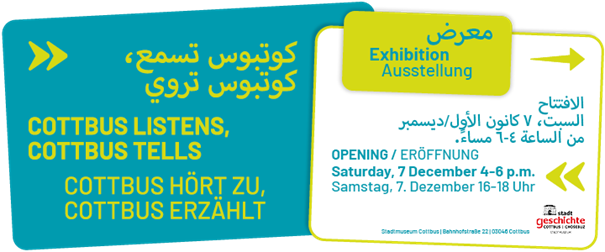Opening of the exhibition “Cottbus listens, Cottbus tells”
Dear friends,
We cordially invite you to the opening of the exhibition “Cottbus Listens, Cottbus Tells” on Saturday, December 7, 2024, 4 pm, at the Stadtmuseum Cottbus.
How do we talk about migration in the past and present? Who is part of this “we”? Whose stories are heard? How can we shape and increase participation and the right to a say?
The exhibition, which was developed as part of the Citizen Science project 'Narrating East German Migration Society' (MigOst)* together with the Geflüchtetennetzwerk Cottbus and the Stadtmusum Cottbus, approaches these questions with regard to the recent history of East Germany, in particular that of the city of Cottbus.
Although East German society also has a past and present shaped by migration, the narrative of its past is dominated by the perspectives of the majority society. The voices of migrant contemporary witnesses are often lost.
Yet they are part of a shared history, make (different) realities of life visible and should be heard and included in current social (self-)understanding processes. The exhibition aims to give migrant voices space. During the GDR era, workers from Vietnam, Poland and Mozambique mined coal in Lusatia or manufactured textiles in the Cottbus textile industry. People came to Cottbus for an apprenticeship or one of the rare university places, others as political emigrants.
From the 1990s, this was followed by ethnic German repatriates, Jewish immigrees (so-called Kontingentflüchtlinge) and war refugees from the former Yugoslavia, later from Syria, Afghanistan and today from Ukraine. Others, such as those born to binational couples in East Germany, have had and continue to have experiences of otherness, even though they themselves did not experience migration.
During the development of the exhibition, contemporary witnesses were encouraged to reflect on and share their own migration stories in a participatory process, to work on common narratives and to pass them on. The permanent exhibition at the Stadtmuseum was actively involved in this discussion by examining its references to migration history, as well as any gaps.
A total of seven storytelling cafés, four city labs and 13 biographical-narrative interviews took place at the Cottbus site. The discussion began with topics chosen by the contributors (Zeitzeug:innen) themselves, such as 'Arriving in Cottbus', 'Living with two cultures', 'Racism and discrimination in everyday life', 'The Cottbus of tomorrow' or 'Past and present: my everyday life in Cottbus'. Later on, they jointly considered how these topics could be presented in an exhibition.
The result is an exhibition that, on the one hand, makes references to the history of migration visible in the permanent exhibition and, on the other, tells the life stories of migrant witnesses through memorabilia. A brochure provides an insight into the most recent migration history of the city of Cottbus and also links this with the life stories of the contributors.
The exhibition invites you to gain new perspectives on Cottbus in the past and present and to get to know the people who made Cottbus their new center of life.

